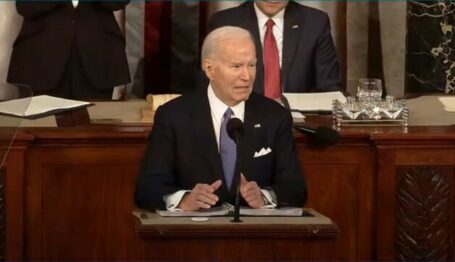Labor Watch
Teachers’ Unions vs. Teachers, Parents, and Children: Electing the Boss
 The first graders [my wife] Aubree is teaching haven’t known school outside of COVID. These kids struggle to get through a full in-person school day. Credit: Jasmine Barnes. License: https://bit.ly/44HxvfC.
The first graders [my wife] Aubree is teaching haven’t known school outside of COVID. These kids struggle to get through a full in-person school day. Credit: Jasmine Barnes. License: https://bit.ly/44HxvfC.

Teachers’ Unions vs. Teachers, Parents, and Children (full series)
The NEA and AFT | Political Juggernauts | Electing the Boss
“Racial Justice” Ideology | The COVID-19 Lesson
Electing Their Own Boss
Government unions differ from those in the private sector in many ways, but foremost is that described by Terry Moe: “By participating actively in electoral campaigns…and by using their members, money, and organizations to get favored candidates elected to office, the unions can play a role in selecting the very people they will be bargaining with (emphasis in original).”[1] Moe notes that the Michigan Education Association actually distributes a how-to manual to its members titled “Electing Your Own Employer, It’s as Easy as 1, 2, 3.”[2]
Unfortunately, this cozy arrangement excludes We the Taxpayers, who get to shell out for this almost obscene exercise in mutual back-scrubbing.
A particularly egregious example of teachers’ unions selecting their own employer occurred in a 2019 school board election in Centralia, Washington, which has all of thirteen thousand registered voters.
A former Freedom Foundation staffer, Jami Lund, was running for reelection as an incumbent. Jami was well qualified for the position: not only had he spent sixteen years as a senior policy analyst at the Freedom Foundation, where he was recognized as a top scholar on education policy and finance, but he was a twenty-year Centralia resident whose three grown sons had graduated from Centralia schools.
Jami was a popular guy and a tireless campaigner. He raised over $14,000 from over 140 donors. His opponent raised only $100 from local sources, and that from a single donation. Yet she won by a razor-thin margin of 2,543–2,435.
How did it happen? Simple: the Washington Education Association, Washington Federation of State Employees, the Service Employees International Union, and other unions spent more than $92,000 to defeat Jami. As he said, that was “a lot of campaign money to overcome in a volunteer school board race.” Jami’s opponent did not want to be associated with dirty politics and asked the WEA to stop politicking on her behalf, but the union just kept dumping its members’ money into the race. The special interests spent more than seven dollars per registered voter to send a message: if you disagree with the WEA, they will use all their resources to defeat you.
Choosing your own boss means dictating your terms of employment—and shafting the taxpayers.
In addition to salaries and benefits, collective bargaining also determines the rules under which schools operate. Up for negotiation is everything from paid leave to disciplining teachers, and from the length a faculty meeting may last to how a senior teacher goes about poaching the job of a junior teacher. These rules are often byzantine in their complexity and mind-blowing in their pettiness. They exist to serve one end: the desires of teachers and their union. Children, and the quality of education they receive, play no role in their establishment.
“Teachers are members of the pension elite,” writes Moe.[3] The union-supported elected officials give them retirement benefits which dwarf those of the vast majority of Americans. Typically, they retire young—no hanging on till sixty-two or sixty-five or even seventy like most working stiffs—and almost all teachers are members of guaranteed-annuity “defined-benefit” programs whose munificence and liberality can be staggeringly lavish for those teachers who work twenty-five years or more. Six-figure pensions are not uncommon.
Teachers, says Moe, are “among the most advantaged American workers when it comes to health insurance.” Almost all (95 percent) receive health insurance as a perquisite of their job, whereas in the private sector less than two-thirds of workers do. Close to half of teachers (43 percent) do not have to pitch in toward their monthly premiums.[4] Their coverage is also likelier to be gold-plated than that enjoyed by workers in the private sector—that is, by the workers whose taxes pay the salaries and benefits of those teachers.
***
Teachers’ unions actively fight against a quality education for our kids. That sounds harsh, but it’s true. Their agenda is not to educate our children but rather to grow the size of government, and in particular those activities of government that have to do with education.
If pouring more money into education somehow achieved a better educational system, then they might have an argument. But for decades now, one of the most established and irrefutable findings of social science has been that there is no positive relationship between spending and quality in public education. If anything, the reverse is true: the more money spent, the worse students fare along a variety of measurements, from graduation rates to test results.
The most recent data reveal that New York City ($25,139) and the District of Columbia ($22,406) spend the most per pupil on public education.[5] And Philadelphia spends around $24,000 per student, but only 17 percent of eighth graders are proficient in reading.[6] The District of Columbia—the nation’s capital—is consistently at or near the bottom in reading, mathematics, and science test scores, and New York City is usually just above them, firmly entrenched in the bottom half.
The states in which the teachers’ unions have achieved the greatest influence typically score poorly on a wide range of measures. Examples are voluminous. To take just one, in 2019, the last year before COVID distorted state participation rates, the states with the most powerful teachers’ unions—California, New York, Illinois, Oregon—were in the lowest third of the National Assessment of Educational Progress (NAEP) tests in Grade 4 Mathematics.[7]
Oregon hit upon one failsafe way to improve its near-the-bottom graduation rates. The prospects for any serious education reform in the state were nil, given the chokehold that the teachers’ unions have on the state legislature and the governor’s office. The solution? To increase graduation rates, let’s lower standards! So now you can emerge fully fledged from a public high school in the Beaver State without knowing how to read or write or do math.
Ain’t that great?
In the next installment, teachers unions are following the hard Left’s playbook by pushing critical race theory.
This article is abridged version of chapter 4 of Freedom Is the Foundation: How We Are Defeating Progressive Tyranny by Aaron Withe (Post Hill Press, 2023). The citations were renumbered for this version. Subheadings and images were added for the web version.
[1] Terry M. Moe, Special Interest, p. 112.
[2] Ibid., p. 113.
[3] Ibid., p. 165.
[4] Ibid., pp. 167–168.
[5] “Public School Spending Per Pupil Increases by Largest Amount in 11 Years,” US Census Bureau, May 18, 2021, https://www.census.gov/news-room/press-releases/2021/public-school-spending-per-pupil.html
[6] Jeff Yass, “Money for Children’s Education, Not Schools,” Wall Street Journal, June 22, 2022, https://www.wsj.com/articles/money-for-children-not-schools-students-education-k-12-cost-prices-inflation-system-math- reading-11655924112
[7] “The Nation’s Report Card: 2019,” https://www.nationsreportcard.gov/profiles/stateprofile?chort=2&sub=RED&sj=AL&sfj=NP&st=MN&-year=2019R3



